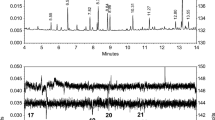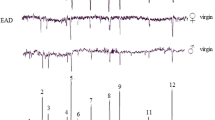Abstract
Electrophysiological tests were done on larval and adult stages of Chilo partellus. The first tarsomere on the forelegs of the moths has three pairs of sensilla; two of them have similar ultrastructural details and they are innervated by gustatory cells which respond equally well to maize leaf exudate but differ in their sensitivity to sucrose. Although the third pair has morphological features resembling those of contact chemoreceptor, it responds to mechanical stimulation only. Taste sensilla on the ovipositor are more sensitive to NaCl than sucrose and they respond to the unknown components in the maize leaf exudate. On the larval maxillae the lateral styloconica sensilla are very sensitive to sucrose and the aqueous extracts from susceptible and resistant maize cultivars; the medial styloconica sensilla are mainly sensitive to NaCl and the aqueous exudate from maize stems. Preliminary tests showed that treated maize piths can provide a suitable medium for the bioassay of larval feeding behaviour.
Résumé
Des tests électrophysiologiques ont été faits sur le Chilo partellus au stade larvaire et adulte. Le premier tarsomère sur les avant pattes des insectes a trois pairs de sensilla; deux desquelles ont des détails structurels similaires et elles sont innervées par de cellules du goût qui réagissent aussi bien à l’exudat de la feuille de mais maïs diffèrent quant à leur sensibilité au sucrose. Quoique la troisième paire a des aspects morphologiques ayant une ressemblance avec ceux du chemorecepteur de contact, elle ne réagit qu’à la stimulation mécanique. Les sensilla gastotoires sur l’ovipositeur sont plus sensibles au NaCl qu’au sucrose et elles réagissent aux composés inconnus dans l’exudat de la feuille de maïs. Les sensilla stylonica latéraux sur les maxillae larvaires sont très sensibles au sucrose ainsi que aux extraits aqueux provenant des cultivars de maïs susceptibles et resistants; les sensilla styloconica mediales sont surtout sensibles au NaCl et l’exudat acqueux provenant des tiges de maïs. Des tests préliminaires ont montré que des plants de maïs traité peuvent constituer un milieu adéquat pour l’essai biologique sur le comportement alimentaire larvaire.
Similar content being viewed by others
References
Ampofo J. K. O. (1985) Chilo partellus (Swinhoe) oviposition and larval behaviour on some resistant and susceptible maize genotypes. Insect Sci, Applic. 6, 323–330.
Den Otter C. J. and Kahoro H. M. (1983) Taste cell responses of stemborer larvae Chilo partellus (Swinhoe), Eldana saccharina Wlk. and Maruca testulalis (Geyer) to plant substances. Insect Sci. Applic. 4, 153–157.
Ishikawa S., Hirao T. and Arai N. (1969) Chemosensory basis of host plant selection in the silkworm. Entomologia exp. appl. 12, 544–554.
Ma W. C. (1969) Some properties of gustation in the larva of Pieris brassicae. Entomologia exp. appl. 12, 584–590.
Ma W. C. (1976) Mouth parts and receptors involved in feeding behaviour and sugar perception in the African armyworm Spodoptera exempta (Lepidoptera, Noctuidae). Symp. Biol. Hung. 16, 129–136.
Ma W.-C. and Schoonhoven L. M. (1973) Tarsal contact chemosensory hairs of the large white butterfly Pieris brassicae and their possible role in oviposition behaviour. Entomologia exp. appl. 16, 343–357.
Saxena K. N. (1969) Patterns of insect-plant relationships determining susceptibility or resistance of different plants to an insect. Entomologia exp. appl. 12, 751–766.
Schoonhoven L. M. (1968) Chemosensory basis of host plant selection. A. Rev. Ent. 13, 115–136.
Schoonhoven L. M. (1973) Plant recognition by lepidopterous larvae. Symp. ent. Soc. Lond. 6, 87–99.
Schoonhoven L. M. (1977) Insect chemosensory responses to plant and animal hosts. In Chemical Control of Insect Behaviour. Theory and Application (Edited by Shorey H. H. and McKelvey J. J. Jr), pp. 7–14. Wiley, New York.
Waladde S. M. (1983) Chemoreception of adult stem-borers: Tarsal and ovipositor sensilla on Chilo partellus and Eldana saccharina. Insect Sci. Applic. 4, 159–165.
Author information
Authors and Affiliations
Rights and permissions
About this article
Cite this article
Waladde, S.M., Kahoro, H.M., Kokwaro, E.D. et al. Responses of Chilo partellus to Material Obtained from Susceptible and Resistant Maize Cultivars. Int J Trop Insect Sci 6, 341–347 (1985). https://doi.org/10.1017/S1742758400004616
Received:
Revised:
Published:
Issue Date:
DOI: https://doi.org/10.1017/S1742758400004616




